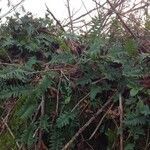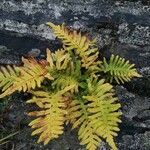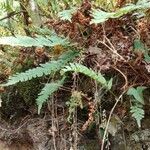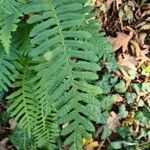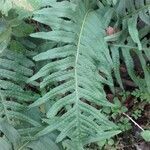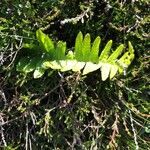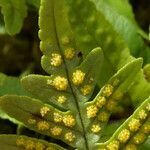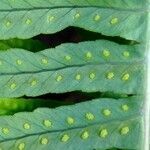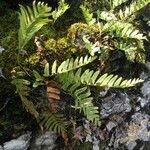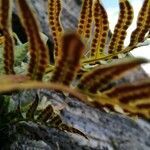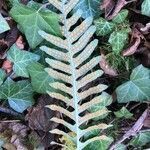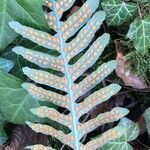Rhizome long creeping, 3-4 mm in diam., densely scaly; scales pale brown, lanceolate with ovate peltate base, 4-5 mm, margin toothed, apex acuminate. Fronds remote. Stipe straw-colored, 5-10 cm, densely scaly at base, glabrescent upward. Lamina pinnatifid or pinnatisect, oblong-lanceolate in outline, 10-20 × 5-7 cm, herbaceous or subleathery, glabrous, apex shortly caudate. Segments 12-15 pairs, oblique, lanceolate, 3-4 × 0.5-0.8 cm, decurrent to adjacent lobes by very narrowly winged rachis, margin toothed, apex obtuse or acute. Veinlets hardly visible. Sori medial or slightly closer to costa.
Rhizome 2-4 mm in diameter, set with lanceolate acuminate, entire, concolorous brown rhizome-scales up to 5 mm long. Fronds erect, firmly herbaceous, spaced up to 10 mm apart; stipe stramineous to pale brown, glabrous, 18-170 mm long; lamina ovate-oblong to narrowly oblong-acute, 30-230 x 22-88 mm, pinnatifid to very near midrib into narrowly oblong to linear, obtuse to acute, entire (except for regular minute notches) lobes up to 45 x 7 mm, glabrous on both surfaces; midrib convex on both surfaces. Sori up to 22 per lobe, placed about halfway between costa and margin, up to 3 mm in diameter.
A small fern. It grows 15-38 cm high and spreads indefinitely sideways. The rhizome is tough and creeping. The fronds are sword shaped, leathery and dark green. They rise from the rhizome. It can grow in soil or attached to other plants or objects. The fruiting bodies or sori are large and round. They are bright orange to reddish-brown.
Epilithic or rarely epiphytic. Rhizome creeping, scales pale brown. Fronds erect, pinnate, lamina narrowly ovate to oblong, 80-200 x 35-75 mm, texture thickly coriaceous, lamina and stipe glabrous, margins entire to slightly wavy or irregular. Sporangia in round, exindusiate sori born in single row on each side of pinna midrib.
Rhizomes long-creeping. Stipes 2-20 cm long, lacking scales except at very base. Laminae ovate or narrowly elliptic, 1-pinnate, 10-25 × 5-9 cm. Primary pinnae in 10-25 pairs, oblong, obtuse, decurrent, minutely serrate, to 5 × 1 cm. Sori round or elliptic, in 2 rows either side of midrib.
Rhizomatous perennial. Fronds spaced, erect, soft, stipe glabrous, lamina ovate-oblong, pinnatifid to near midrib into oblong, entire lobes. Null Sori round, to 22 per lobe, to 3 mm diam.
